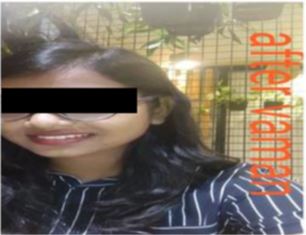Vaman Karma in Yauvan Pidika (Mukhdushika) w.s.r. to Acne Vulgaris : A Case Study
Keywords:
Acne vulgaris, Madanaphala Pippali, Samsarjana Krama, Snehapana, Vasantika Vamana, Yauvanapidika.Abstract
Face is considered as an important part of the body as far as beauty and look is concerned. Hence, everyone in general and youngsters in particular are very cautious about beauty of their face. Acne vulgaris (A.V) is a disease of the pilosebaceous origin that causes non-inflammatory lesions (papules, pustules and nodules) and varying degrees of scarring. In Ayurveda Yauvanapidika (Acne vulgaris) is such a condition that disfigures the face during adolescent to younger age. If the condition remains untreated, it leaves permanent scars over the face. According to Ayurveda, vitiation of Kapha Dosha, Vata Dosha and Rakta Dhatu lead to development of Mukhadushika or Yauvanapidika which have resemblance with acne vulgaris in modern texts. Both modern and Ayurvedic sciences have considered the use of topical as well as oral medicines and their combination for the management of acne vulgaris. No doubt modern medication provides quick relief from acne vulgaris but cause noticeable side effects. Nowadays herbal formulations and Ayurvedic therapy are the superior choices for cosmetic purposes among the most of the population. So, the aim and objectives of this article is to minimize the side effects of Allopathic medicine in Acne vulgaris (A.V) as well as to popularized the Vamana therapy (one of the procedures of Panchakarma therapy) by a case study of 25 yrs old female patient having complaints of recurrent erythematic papules and pustules along with dark spots on her face. She was given Shodhana Therapy (Vamana therapy) and then Shaman Chikitsa (Panchkol Phanta, Chitrakadi Vati, Liv 52 DS). She got good result in Yauvanapidika (Acne vulgaris).
Downloads
References
Knutsen-Larson, S. Dawson AL, Dunnick CA, Dellavalle RP. Acne vulgaris: Pathogenesis treatment and needs assessment. DERMATOL CLIN 2012; 30:99- 106.
Kubba R, Bajaj AK, Thappa DM, Sharma R, Vedamurthy M, Dharma S, et al. Acne and quality of life, Indan J Dermatol Venerol Leprol 2009;75(s1):4-5.
Kaviraj Ambikadatta Shastri editor of Susruta Samhita with Ayurveda Tattva Sandipika; Reprint Edition: 2012; Nidana Sthana; Chapter-13; Page No.365.
Kaviraj Ambikadatta Shastri editor of Susruta Samhita with Ayurveda Tattva Sandipika: Reprint Edition, 2012; Nidana Sthana; chapter-13; Page No. 372.
Kaviraj Ambikadatta Shastri editor of susrutha Samhita with Ayurveda Tattva Sandipika Reprint Edition, 2012; Nidana Sthana; chapter-13; Page No. 364.
Tahir CM. Pathogenesis of acne vulgaris: Simplified. J Pak Assoc Dermatol2010;(20):93-7.
Collier CN, Harper JC, Cantrell WC, Wang W, Foster KW, Elewski BE. The prevalence of acne in adults 20 years and older. J Am Acad Dermatol2009;58(1):56-9.
Hedden SL, Davidson S, Smith CB. Cause and effect: The relationship between acne and self-esteem in adolescent years. J Nurse Pract 2008;4(8):595-600.
Munavalli GS, Weiss RA. Evidence for laser- and light-based treatment of acne vulgaris. Semin Cutan Med Surg 2008;27(3):207-11.
Liao DC.Management of acne. J Fam Practice 2003;52(1):43-51.
Jain A, Basal E. Inhibition of Propionibacterium acnes-induced mediators of inflammation by Indian herbs. Phytomedicine 2003;10(1):34-8.
Amrita G, Greeshma N, Deepa M, Poornima EH. A review on anti-acne potential of medicinal plant extracts against Propionibacterium acnes. International Journal Pharma Bio Sci 2012;3(3):987-9
Longshore SJ, Hollandsworth K. Acne vulgaris: One treatment does not fit all. Cleve Clin J Med 2003;70(8):670-80.
Kumar S, Palbag S, Maurya SK, Kumar D. Skin care in Ayurveda: A literature review. International Research Journal of Pharmacy 2103;4(3):1-3.
Bedi MK, Shenefelt PD. Herbal therapy in dermatology. Arch Dermatol 2002;138(2):232-42.
Sharma A, Sharma PV. Sushruta Samhita. Volume-I. Varanasi: Chaukhambha Surbharati Prakashan; Reprint Edition, 2012; Page No. 559.
Gupta A, Upadhyaya Y. Ashtanga Hrudaya of Vagbhata. Varanasi: Chaukhambha Prakashan; Reprint Edition, 2012; Page No. 765.
Kaviraj Ambikadatta Shastri editor of Susruta Samhita with Ayurveda Tattva Sandipika Reprint Edition: 2012; Nidana Sthana; Chapter-13; Page No. 372.
Sharma H. Bhishgacharya; S. Kashyapa Samhita of Vridhjivaka; Varanasi Chaukhamba Sanskrit sansthan; Reprint Edition: 2012; Page No. 79.
Vd. Acharya YT, Editor Charaka Samhita of Agnivesha revised by Charka and Drdhabala with Ayurveda Dipika commentary of chakrapanidatta New Delhi: Chaukhamba publication; Edition: 2016; Sutra Sthana; Chapter-16; verse No.20; Page No. 97.
Vagbhata. Ashtanga Hridaya with commentary Sarvangasundara and Ayurveda Rasayana, Chowkhamba Surbharati Prakashana Varanasi; Reprint Edition: 2010; Sutra Sthana; Chapter-18; verse No.3; Page No.260.
P.V.Sharma Acharya. Dravya Guna Vijnana vol. 2; Reprint Edition: 2013; Chaukhamba Bharati Academy Varanasi; Page No.28-31.
P.V.Sharma Acharya. Dravya Guna Vijnana vol. 2; Reprint Edition: 2013; Chaukhamba Bharati Academy Varanasi; Page No.376- 379.
P.V.Sharma Acharya. Dravya Guna Vijnana vol. 2; Reprint Edition: 2013; Chaukhamba Bharati Academy Varanasi; Page No. 28-31.
P.V.Sharma Acharya. Dravya Guna Vijnana vol. 2; Reprint Edition: 2013; Chaukhamba Bharati Academy Varanasi; Page No. 376 -379.















